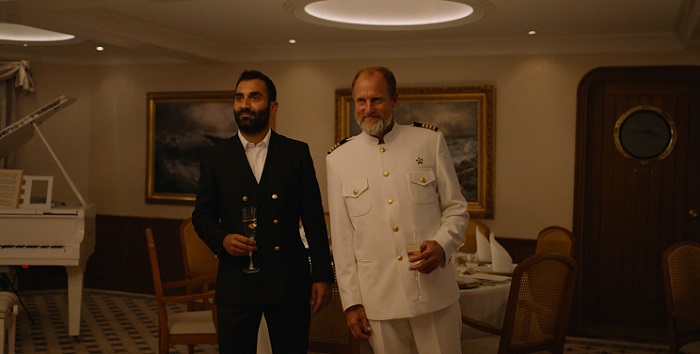The rich and pampered have become a favorite punching bag of filmmakers and studios (it’s hard to miss the baked-in irony of that statement). It makes sense considering the snobbish upper crust elites routinely give us new things to scrutinize and satirize. So you could call them an easy but deserving target. The latest film to take a big swing at the wealthy and privileged is Swedish director Ruben Östlund’s “Triangle of Sadness”.
This satirical black comedy surprised a lot of people by winning the Palme d’Or at this year’s Cannes Film Festival. Early critics scores revealed a more mixed reaction, and understandably so. “Triangle of Sadness” is a peculiar movie – one whose blistering intentions are so clear from scene to scene that there’s no room whatsoever for subtlety or nuance. In fact, its heavy-handedness is so pronounced it drags the movie down on a few occasions. Yet there are other times when the Östlund’s bluntness feels like part of the joke.
Perhaps the most surprising (and perplexing) thing about “Triangle of Sadness” is in seeing how much more Östlund enjoys poking fun at the one-percenters and relishing in their suffering than saying anything new and insightful about them. Yes, there are some pointed cuts at the systems that provided and sustains their wealth, and we get some obvious commentary on class disparities and skewed power dynamics. But this is mostly a all-out basting and humiliation of the rich and powerful.
But don’t get me wrong, part of the mad genius of Östlund’s batty concoction is in how he takes everything I said above and makes it into something so thoroughly entertaining. “Triangle of Sadness” is a blast, firing off a number of good laughs through both its overt directness and its unbridled absurdity. Östlund’s irreverent style is tailor-made for such a scourging. And though there’s nothing revelatory in his portrayal of the uber-wealthy, he exaggerates his perception in such a way that we’re always given something to chew on.
The closest we get to protagonists are Carl (Harris Dickinson) and Yaya (Charlbi Dean). They’re a young couple in the literal sense, but it’s hard to tell if their relationship is built on true affection or social clout. Carl is your prototypical male model and makes most of his money with his shirt off. Yaya is a social media influencer whose success is based more on followers than revenue. Both live off of their good looks, but it’s hardly a lucrative business. Yet they happily live above their means, in large part thanks to the freebies Yaya gets from companies hungry for free advertising.
One such freebie is a luxury cruise on a $250 million yacht. Carl and Yaya join an assemblage of obscenely rich high-society types that includes a Russian fertilizer magnate (Zlatko Burić) and his self-deluded wife (Sunnyi Melles), an elderly British couple (Oliver Ford Davies, Amanda Walker) who made their fortune on hand grenades, a disabled German woman (Iris Berben) who continually shouts “In Den Wolken” (which means “in the clouds”), and a forlorn mobile app creator (Henrik Dorsin) among others.
The very makeup of the ship could be a reflection of class structures around the world. The privileged out-of-touch cruisers soak up the amenities of the lavish upper deck where mostly white servers pamper them in anticipation of huge tips. Meanwhile the predominantly non-white service members stay in cramped cabins below. They’re considered part of the service crew, but not allowed to be seen topside. Like many things, it isn’t the slightest bit subtle, but nor is it trying to be.
While the first half focuses on the privilege the rich enjoy, the second half explores what happens when they have it taken away. But connecting those two halves is what’s sure to be considered the film’s signature scene – a posh Captain’s Dinner that goes horribly wrong. Let’s just say it involves spewing vomit, overflowing toilets, turbulent seas, and the ship’s stone-drunk captain (a hysterical Woody Harrelson). It sends the story careening into its third act as a select number from the boat find themselves stranded on a deserted island. Once there, class status is tossed, gender roles are reversed, weaknesses are exposed. But being good-looking still has its benefits.
Unfortunately Östlund doesn’t see his story through to the end. Instead he takes an easy out, giving us an ambiguous ending that doesn’t offer any real conclusion. It’s the old “you determine for yourself” finish which often works nicely. But in a movie like this, where everything is so straightforward and Östlund is basically shooting fish in a barrel, it really needs to end with a punch.
Still, Östlund gives us plenty to absorb as he runs his filthy rich subjects through the wringer. Some scenes are savagely funny while others are simply savage. More importantly, we’re always engaged. And his satire, though glaringly blunt and without an ounce of subtlety, has bite. “Triangle” is a wild and wildly original film, and it’s hard not to be drawn to it, flaws and all. And though Östlund may whiff on a few of his crazy swings, most of them connect with bludgeoning force. So much so that we may feel a little guilty about laughing at these people’s suffering. Not much, but maybe a little. “Triangle of Sadness” is now showing in select theaters.
VERDICT – 4 STARS





I really want, nay, need, to see this movie. Woody is great at this kind of movie. He’s made for them! Hoping it comes to a theater near me.
It is a bonkers satire. I really wish it had ended stronger, but I had so much fun along the way. It’ll be interested to see what kind of distribution it will get.
Me too. Honestly, I don’t think there can be too many slicing and dicing the 1%ers. They’ve been dictating to culture in so many ways for a very long time. It’s time to take the gloves off. I really want to see a movie that has something creative, morbid, and memorable happen to someone driving a Hummer.
This certainly will give you plenty of what you’re looking for. Ostlund goes at the upper-crust with guns ablazin’. It’s a hoot.
That sounds fun!
It’s a hoot. I think you would get a kick out of it.
I’m going to wait for this on streaming hopefully for next year’s Cannes Marathon in May. I loved Force Majeure but I thought The Square was overrated.
I’m right there with you on both FORCE and THE SQUARE. This movie is unlike either of those. It’s wildly original but also a little insane. And I say that as a compliment.
I’ll be checking this out for sure. It’s actually been a minute since I’ve stepped foot inside a theater (you might be able to glean that from my cobweb-gathering blog) but this is something that screams theater. Sounds like a blast, despite, yeah, the irony of a wealthy filmmaker skewering the wealthy.
It’s an absolute hoot. Sadly I wasn’t able to see it on the big screen, but if it FINALLY opens anywhere nearby I’ll be giving it another go.
I hope to see this. Right now it isn’t playing anywhere near me.
I’m not surprised. The release strategy for this hasn’t made a lot of sense to me. I hope you get to see it soon though.